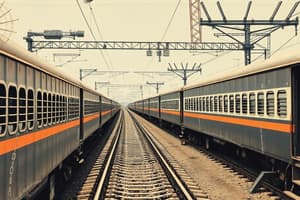Podcast
Questions and Answers
Which of the following factors has NOT significantly influenced the distribution of India's railway network?
Which of the following factors has NOT significantly influenced the distribution of India's railway network?
- Political ideologies (correct)
- Physiographic features
- Administrative boundaries
- Economic activity
What was a major challenge encountered in constructing railways in the Himalayan mountainous regions?
What was a major challenge encountered in constructing railways in the Himalayan mountainous regions?
- Lack of sufficient raw materials for construction
- Opposition from local communities
- Limited availability of skilled labor
- Extreme weather conditions and terrain (correct)
Which of the following regions presented a particularly challenging landscape for railway construction due to its physical characteristics?
Which of the following regions presented a particularly challenging landscape for railway construction due to its physical characteristics?
- The Deccan Plateau
- The Northern Plains
- The Western Ghats (correct)
- The Konkan Coast
What is the significance of the Konkan Railway in India?
What is the significance of the Konkan Railway in India?
Why are the Northern Plains considered ideal for railway development?
Why are the Northern Plains considered ideal for railway development?
What was the main reason for the construction of the first railway line in India?
What was the main reason for the construction of the first railway line in India?
Which of the following is a significant problem faced by the Konkan Railway?
Which of the following is a significant problem faced by the Konkan Railway?
What is the significance of the Indian Railways for the country's economy?
What is the significance of the Indian Railways for the country's economy?
Flashcards are hidden until you start studying
Study Notes
Importance of Railways in India
- Railways are the primary mode of transportation for freight and passengers in India.
- They enable people to conduct various activities like business, sightseeing, and pilgrimage, along with the transportation of goods over long distances.
- Indian Railways have been a great integrating force for over 150 years, binding the country's economic life and accelerating industrial and agricultural development.
History of Indian Railways
- The first train in India ran from Mumbai to Thane in 1853, covering a distance of 34 km.
Distribution Pattern of Railway Network
- The distribution pattern of the Railway network in India has been influenced by physiographic, economic, and administrative factors.
- The northern plains have provided the most favorable conditions for the growth of railways due to their vast level land, high population density, and rich agricultural resources.
Challenges in Building Railway Lines
- The construction of railway lines has been hindered by the need to build bridges across wide rivers in the northern plains.
- In the hilly terrains of the peninsular region, railway tracts have been laid through low hills, gaps, or tunnels.
- The Himalayan mountainous regions have been unfavorable for railway construction due to high relief, sparse population, and lack of economic opportunities.
- Laying railway lines has been difficult in the sandy plain of western Rajasthan, swamps of Gujarat, forested tracks of Madhya Pradesh, Chhattisgarh, Odisha, and Jharkhand.
- The contiguous stretch of Sahyadri could be crossed only through gaps or passes (Ghats).
Recent Developments in Railway Network
- The development of the Konkan railway along the west coast has facilitated the movement of passengers and goods in this economically important region of India.
- However, this project has faced problems such as sinking of tracks in some stretches and landslides.
Studying That Suits You
Use AI to generate personalized quizzes and flashcards to suit your learning preferences.




